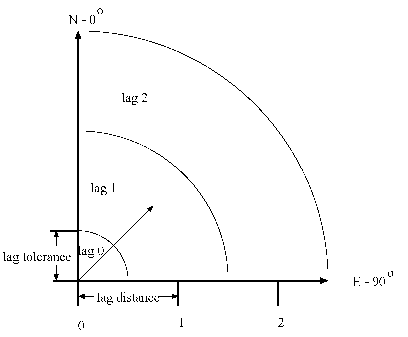| The VARIOGRAM Procedure |
Distance Classification
The distance class for a point pair  is determined as follows. The directed line segment
is determined as follows. The directed line segment  is superimposed on the coordinate system showing the distance or lag classes. These classes are determined by the LAGDISTANCE= option in the COMPUTE statement. Denoting the length of the line segment by
is superimposed on the coordinate system showing the distance or lag classes. These classes are determined by the LAGDISTANCE= option in the COMPUTE statement. Denoting the length of the line segment by  and the LAGDISTANCE= value by
and the LAGDISTANCE= value by  , the lag class
, the lag class  is determined by
is determined by
 |
where  denotes the largest integer
denotes the largest integer  .
.
When the directed line segment  is superimposed on the coordinate system showing the distance classes, it is seen to fall in the first lag class; see Figure 95.13 for an illustration for
is superimposed on the coordinate system showing the distance classes, it is seen to fall in the first lag class; see Figure 95.13 for an illustration for  .
.
 Falls within the First Lag Class
Falls within the First Lag Class

Because pairwise distances are positive, lag class zero is smaller than lag classes  MAXLAG
MAXLAG . For example, if you specify LAGDISTANCE=1 and MAXLAG=10, and you do not specify a LAGTOL= value in the COMPUTE statement in PROC VARIOGRAM, the 10 lag classes generated by the preceding equation are
. For example, if you specify LAGDISTANCE=1 and MAXLAG=10, and you do not specify a LAGTOL= value in the COMPUTE statement in PROC VARIOGRAM, the 10 lag classes generated by the preceding equation are
 |
This is because the default lag tolerance is half the LAGDISTANCE= value, resulting in no gaps between the distance class intervals. This is shown in Figure 95.14.

On the other hand, if you do specify a distance tolerance with the LAGTOL= option in the COMPUTE statement, a further check is performed to see if the point pair falls within this tolerance of the nearest lag. In the preceding example, if you specify LAGDISTANCE=1 and MAXLAG=10 (as before) and also specify LAGTOL=0.25, the intervals become
 |
Note that this specification results in gaps in the lag classes; a point pair  might fall in an interval such as
might fall in an interval such as
 |
and hence be excluded from the semivariance calculation. The maximum LAGTOL= value allowed is half the LAGDISTANCE= value; no overlap of the distance classes is allowed.
In the section Computation of the Distribution Distance Classes there is a more extensive discussion of practical aspects in the specification of the LAGDISTANCE= and MAXLAGS= options.
Copyright © 2009 by SAS Institute Inc., Cary, NC, USA. All rights reserved.